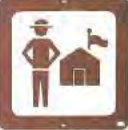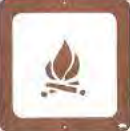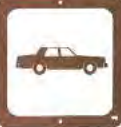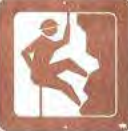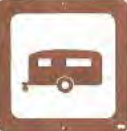Mount Diablo Safety Information
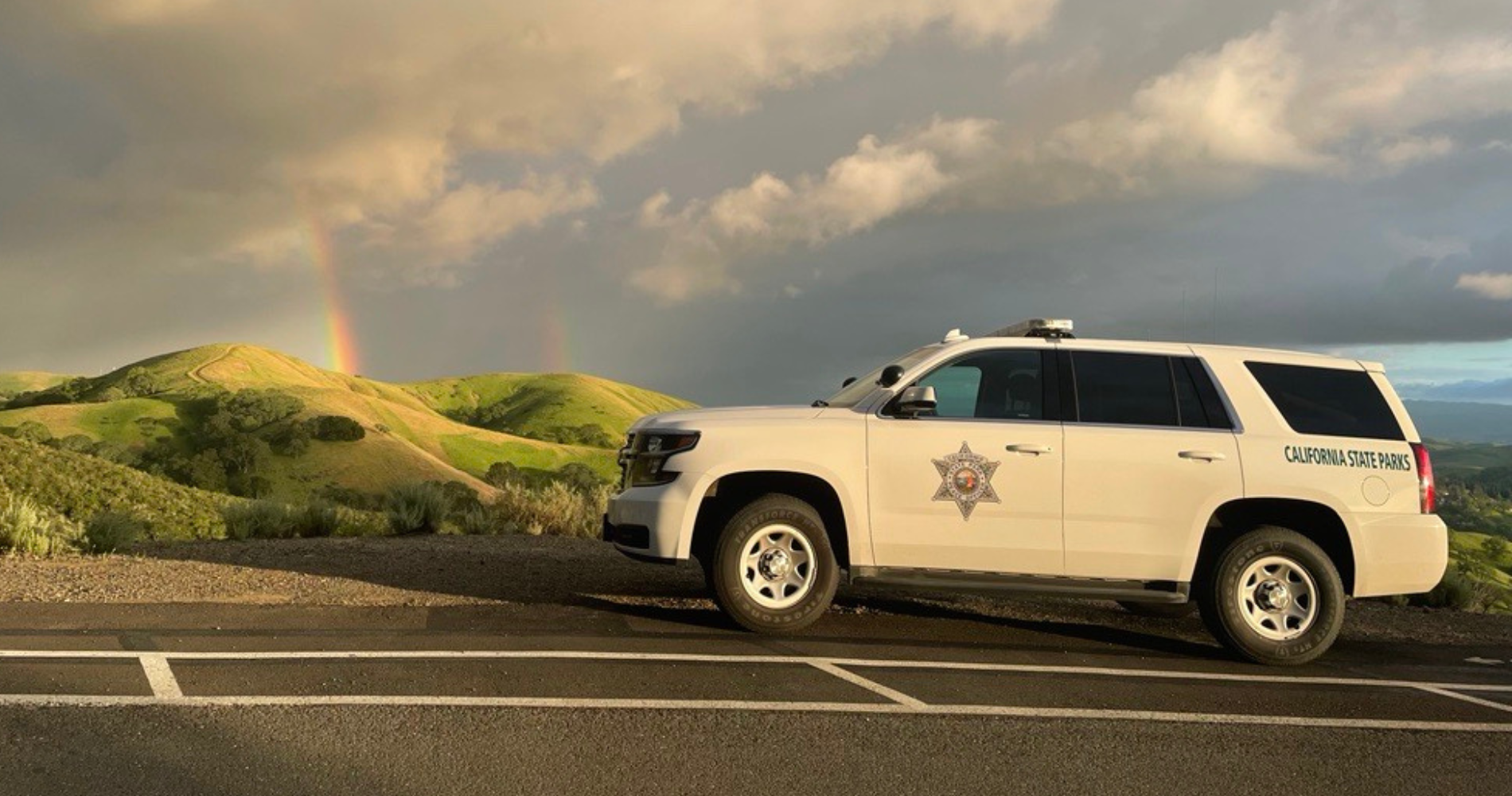
Mount Diablo State Park contains about 20,000 acres of land and 160 miles of trail. The mountain is also one of the highest points in the Bay Area, standing at 3,849 feet at its peak. The park's size and high elevation offers unmatched views and endless places to explore, but these park features can also create danger for individuals who are unprepared. Researching the park’s features and how they can affect your visit is a great way to keep yourself safe during your time at the park. Below are some safety tips for common recreation activities at Mount Diablo.

Planning your Visit
- Check the park's webpage to see any alerts, closures, and notices.
- Always check the weather forecast for the time you are planning on spending at the park. The mountain goes up to high elevations and is inland from the bay, so weather can be more extreme there than in surrounding areas.
- Go over the safety tips for the activity you will be doing in advance.
- Look at a map of the area and plan out the places that you want to visit.
- Remember to plan and pack according to the skill level of yourself and all of the individuals you will be visiting with.
Getting to the Park
- Always use the bike turnouts when cycling or mountain biking at Mount Diablo.
- Only pass bicyclists on roads when there is significant visibility ahead or in areas where there are bike turnouts.
- Don't pass bikes on blind turns.
- Don't park in or block the bicycle turnouts.
- Don't tailgate motorists or bicycles. Leave room between yourself and others on the road in case an abrupt stop is necessary.
- Don't leave pets in the car. Plan ahead and check if pets are allowed in the areas you want to visit. Animals can over heat fast, especially inside of closed cars.
- Don't hop closed gates or enter closed areas. First responders are not on duty when the park is closed, so the closest emergency response is far away at those times. Specific areas in the park may be closed to protect public safety, so entering them can be risky. You can be cited for entering the park outside of its operating hours or for entering closed areas.
- Entrance gates are locked when the park is closed, so plan to be in your vehicle and headed out of the park by sunset to avoid being locked in.
| Fire Danger Chart | ||||||
|---|---|---|---|---|---|---|
| Fire Danger Reading | Wood fire permitted in stoves &BBQ pits (designated picnic and campsites) | Use of Compressed Logs | Use of Charcoal | Use of Self-contained Stove | Cigarette Smoking* | Park Closed* |
| LOW | YES | YES | YES | YES | YES | NO |
| MODERATE | NO | YES | YES | YES | YES | NO |
| HIGH | NO | NO | YES | YES | NO | NO |
| HIGH WITH RED FLAG | NO | NO | NO | YES | NO | NO |
| VERY HIGH/EXTREME | NO | NO | NO | NO | NO | YES |
| * The prohibition of smoking under high fire danger includes smoking within a vehicle. | ||||||
| * Park closure applies to all hikers, vehicles, bicyclists (mountain and road), and horseback riders. | ||||||
- Check the Fire Danger Matrix to determine what you can and cannot burn depending on the time of year.
- Pay attention to park signage during your visit to stay updated on the fire danger reading.
- Keep all fires within the designated stove, fire pit, or Diablo Stove. The ground around the fire source should be kept clear of all flammable material and gear at least 5 feet from the fire.
- Fires shall at all times be maintained in a safe condition.
- Never leave a fire unattended.
- Extinguish all fires prior to departure.
- Ground fires are not permitted.
- Firewood gathering is prohibited.
- Report all wildfires immediately.
The roads at the park are often narrow, winding, and steep. Many spots on the drive up the mountain have limited visibility and blind turns. The roads are used by motorists, cyclists, pedestrians, and the animals that live in the park. For these reasons, it is especially important to practice safe driving strategies when driving at Mount Diablo State Park. Here are some good rules to follow when driving in the park:
.png)
- Obey the posted speed limit.
- Stop at all stop signs.
- Only pass bicyclists at designated passing areas and bike turnouts.
- Don't pass bicyclists on blind curves.
- Don't tailgate bicyclists or other drivers. You cannot see what is ahead past blind curves, so you need to be prepared to make abrupt stops.
- Park off of the road in designated parking stalls or on road shoulders, not in the bike turnout lanes.
- Expect descending bikes and animals on the roadway.
- Take time to read and follow road signage, it offers important information on safety and road conditions.
- Entrance gates are locked when the park is closed, so plan to be in your vehicle and headed out of the park by sunset to avoid being locked in.
- Take your time and drive safely!
Road biking is a popular activity at Mount Diablo. Bikes and class 1 ebikes are also permitted on designated trails. Some general rules to follow when cycling in the park include:
- Obey the posted speed limit.
- When descending, ride at or below the speed limit and always within your abilities.
- Never hop closed gates or enter closed areas. First responders are not on duty when the park is closed, so the closest emergency response is far away at those times. Areas in the park may be closed to protect public safety, so entering them can be risky. You can be cited for entering the park outside of its operating hours or for entering closed areas.
- When riding uphill, ride single file and as far to the right-hand side of the road as possible - always use the bike turnouts.
- If cycling with another person, make sure to leave enough room in the lane for motorists to pass.
- Riding with a group is not recommended. Clustering in a lane or spreading out over a distance makes it difficult for vehicles to pass safely.
- When descending, ride single file and as far to the right-hand side of the road as possible - expect a car or bicyclist to be in your lane around each turn.
- Don't tailgate cars when descending. You cannot see around blind curves, so you must be prepared for abrupt stops.
- Don’t have earphones covering both ears - you can’t hear emergency vehicles or someone warning you of a dangerous situation ahead.
- Don’t “wave” cars to pass you. Use the bike turnouts, let the cars pass where legal, or pull off the road and stop. If you wave one car to pass you and there are several cars behind you, chances are, they will all attempt to pass you.
- Don’t “take the lane”- riding on the left side of the uphill lane to prevent cars from passing you. They will continue to pass you and this only encourages a collision with a descending bicyclist/vehicle or verbal/physical confrontation.
- Make sure to pull off to the side of the road when stopping.
- If you see something dangerous ahead, put your left hand out to signal the vehicle(s) following you to stop and/or not pass.
Bikes and class 1 ebikes are permitted on designated trails in the park. Some general guidelines for mountain biking in the park are:
- When riding on paved roads, follow all rules and guidelines as road bikes. See ‘Cyclist’ section for more information.
- Never hop closed gates or enter closed areas. First responders are not on duty when the park is closed, so the closest emergency response is far away at those times. Specific areas in the park may be closed to protect public safety, so entering them can be risky. You can be cited for entering the park outside of its operating hours or for entering closed areas.
- Always yield on the trail, you are required to yield to horses and hikers.
- Downhill traffic yields to uphill traffic.
- Approach bends and blind spots as if someone were coming. There may be park visitors, animals, or other obstacles out of sight nearby, so you need to be prepared for an abrupt stop.
- Always wear a helmet.
- Stay on designated trails. Do not go off trail as it can pose a threat to both you and the park’s natural resources.
- Stay off of single track trails when they are posted closed.
- Avoid muddy trails, they are easily damaged and can pose danger to those on them.
- The trails and fire roads at Mount Diablo can be challenging to bike, so make sure to always ride within your abilities.
- Many people get injured while mountain biking at the park. The backcountry areas can be very remote and isolated, so help is often far away. Airlifting injured individuals can cost over $50,000.
Passing Lanes and Bike Turnout Map
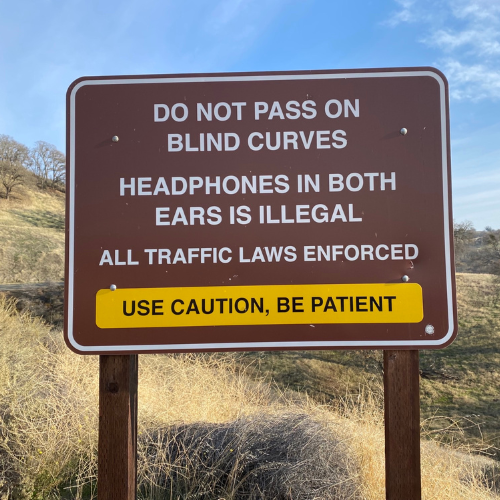
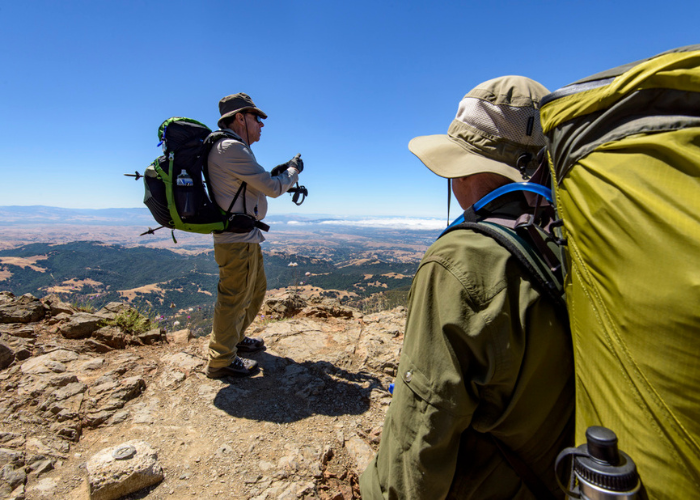
Some safety tips for hiking at Mount Diablo:
- Use the “buddy system” – hike with a friend or family member.
- Drink and carry plenty of water (a minimum of 1 quart every 2 hours).
- Never hop closed gates or enter closed areas. First responders are not on duty when the park is closed, so the closest emergency response is far away at those times. Specific areas in the park may be closed to protect public safety, so entering them can be risky. You can be cited for entering the park outside of its operating hours or for entering closed areas.
- Wear sturdy, comfortable, closed-toed shoes to help prevent injury.
- Stay within designated trails. Do not walk off-trail or enter closed areas.
- Learn to identify shiny, three-leaf pattern of poison oak and stay on trail to avoid coming into contact with it.
- Don't approach, touch, or feed wildlife.
- Maintain a distance of at least 6 feet from snakes and become familiar with what to do in the case of a snake bite.
- Dogs are not permitted on any trails or fire roads in the park. They face a high risk of dehydration and heat exhaustion in the backcountry and there have been fatalities in the past. Only trained, services dogs on leash are allowed on trails and fire roads.
- Trail apps such as Avenza offer free, downloadable maps of the park.
- Bring a map or plan your hike ahead of time, it is easy to get lost in a park that is over 20,000 acres.
- Conserve the battery of your devicesas much as possible while you are hiking, so you can communicate with others if possible and make emergency calls if needed.
- Listening to music or using apps can run your battery down, so consider bringing a portable battery.
- Know your limits and make sure to hike within your ability. It is over 7 miles one way, 3,000 feet in elevation, and at least 4 hours to hike to the summit, so do not attempt it unless you are certain that you will be able to double these numbers to make it back. Calling a ride from the summit can be very expensive and time consuming, and the park does not offer a ride service.
- Many of the trails on Mount Diablo have limited cell service and trails can be very remote, so tell someone at home where you are going and when you plan on getting home. They should notify park staff if you do not return on time.
- Take time to read park signage. If the information is important enough to be posted, it is important enough for your safety.
Some things to remember when riding in the park:
- Check the weather.
- Bring water and know where to find water.
- Bring snacks for you and your horse.
- Know your level: the park's trails can be beginner, intermediate and advanced.
- Groom and condition your horse before leaving the barn.
- Bring your own first aid kit and cell phone. Attach them to your body, not your horse or saddle.
- Ride with a buddy.
- Wear a helmet and protective clothing.
- Don’t forget to put on sunscreen.
- Carry a compass and a trail map.
- Although the rule is that cyclists and hikers yield to horses, be prepared for that not to happen.
- If your horse kicks, tie something red in its tail.
- Make sure to leave enough distance between horses. You should be able to see the hooves of the horse in front of you.

Some guidelines for camping at the park include:
- Check the weather, be prepared. Mount Diablo State Park can have extreme heat, wind, cold, rain, snow, etc.
- Bring extra water. Although the park normally has potable water at the campgrounds, the water source is dependent on spring production. Several years of drought has affected water availability on the mountain. Having additional water on hand ensures a comfortable camping experience.
- Alcohol is prohibited in the park. Do not bring alcoholic beverages camping.
- Park gates are closed at Sunset, arrive well prior to Sunset to ensure arrival and campsite check-in.
- Campers are not allowed to drive in the park at night unless there is an emergency or attending a scheduled Public Astronomy Program at the Summit (per CCR 4326a Superintendents Posted Order)
- For emergencies, call 911. For non-emergencies, contact Parks Dispatch at (916) 358-1300.
- Visitors will be able to reserve campsites and lodging six months in advance from the current date. Reservations can be made by calling Reverve California at 1(800) 444-7275 or by visiting their website.
Campfire Safety
- Pay attention to park signage during your visit to stay updated on the fire danger reading.
- Keep all fires within the designated stove, fire pit, or Diablo Stove.
- The ground around the fire source should be kept clear of all flammable material and gear at least 5 feet from the fire.
- Fires shall at all times be maintained in a safe condition.
- Never leave a fire unattended.
- Extinguish all fires prior to departure.
- Ground fires are not permitted.
- Firewood gathering is prohibited.
- Report all wildfires immediately.
- Check the Fire Danger Matrix below to determine what you can and cannot burn depending on the time of year.
| Fire Danger Chart | ||||||
|---|---|---|---|---|---|---|
| Fire Danger Reading | Wood fire permitted in stoves &BBQ pits (designated picnic and campsites) | Use of Compressed Logs | Use of Charcoal | Use of Self-contained Stove | Cigarette Smoking* | Park Closed* |
| LOW | YES | YES | YES | YES | YES | NO |
| MODERATE | NO | YES | YES | YES | YES | NO |
| HIGH | NO | NO | YES | YES | NO | NO |
| HIGH WITH RED FLAG | NO | NO | NO | YES | NO | NO |
| VERY HIGH/EXTREME | NO | NO | NO | NO | NO | YES |
| *The prohibition of smoking under high fire danger includes smoking within a vehicle. | ||||||
| *Park closure applies to all hikers, vehicles, bicyclists (mountain and road), and horseback riders. | ||||||
Mount Diablo State Park is a popular destination for rock climbers. Many climbers learn and practice their skills on Rock City’s outcrops. The sandstone’s relatively hard exterior is ideal for bouldering and rock climbing. To preserve the character of these unique rock formations and minimize the impact on soils, vegetation, wildlife, and other climbers and visitors, Mount Diablo State Park encourages low-impact climbing and “Leave No Trace” practices. Some climbing guidelines to ensure the safety of you and the park’s resources include:
- Observe all park rules and closures and check park notices before climbing for possible restrictions to protect nesting birds, other wildlife, and areas recovering from overuse.
- Installation of new bolts is prohibited. If a bolt needs maintenance, please contact Feedback.MountDiablo@parks.ca.gov
- Help prevent erosion by using only existing access trails. The park’s topsoil is fragile and easily displaced from the steep slopes in much of the park.
- Protect park vegetation, as these plants and trees provide food and shelter for wildlife. Do not damage mosses, lichens, and branches.
- Respect the integrity of the rock and the climb and do not chip, glue, remove, or otherwise alter the rock.
- Don't climb past the cables on Sentinel Rock. This is to protect and preserve its natural features.
- Avoid overcrowding as large groups have large impacts. Explore another climbing route or wait for the area to clear up if there are too many people are at one location.
- Wait to climb after a rain because sandstone becomes fragile after rain. Please allow two or three days after a heavy rain, or until rocks are completely dry before climbing.
- Consider finding a spot in a climbing class when first starting out. Rock climbing classes and similar activities are regularly offered on the mountain by REI and other organizations.
The roads at Mount Diablo State Park are steep, narrow, and winding with tight curves. The roads are shared by vehicles, bicycles, pedestrians, and animals that live in the park. There are many limited visibility and blind turns on the drive up the park’s roads. For these reasons, vehicles over 24’ in length are not recommended for driving at Mount Diablo State Park.
Here are some guidelines for driving larger vehicles at the park:
- Pre-driving the roads in a smaller car (if possible) will help you know what to expect when driving the large vehicle.
- Buses should not pass bicycles unless they can do so safely when:
- The bike has completely pulled off the road or into a bicycle turnout.
- Signs and roadway markings indicate that it is a legal passing area and the pass can be completed safely.
- If traveling by a bus larger than 20 feet, we ask that you have a pilot car.
The procedures for driving with a pilot car include:
- A passenger in the pilot car should be in communication with a designated passenger on the bus (not the driver).
- The driver of pilot car should turn on their hazard lights to increase visibility.
- The pilot car should notify the bus when traffic is approaching.
- When notified of approaching traffic, the bus should come to a stop in its own lane and wait for the oncoming traffic to pass.
- This is especially important when approaching tight curves where, due to their size, buses must cross the centerline.
- The pilot car needs to be far enough ahead to allow time for the bus to stop in its own lane before the approaching traffic gets there.
- There are places where cellphone reception drops out. Good quality two-way radios are recommended for best communication.
- Bus drivers should not rely solely on communication with the pilot car. They:
- are still responsible for watching for traffic and other road conditions.
- should still exercise extra caution on curves.
- should honk their horn before they reach a curve.
Additional Safety Resources
Poison OakPoison oak grows on the edges of the trails at the park. The California Control System has tips for the identification, prevention, and treatment of poison oak rashes.
Rattlesnakes
During warmer months, venomous rattlesnakes are common in the park. The California Poison Control System offers information on the prevention and treatment of rattlesnake bites.
Tick-Borne Disease Prevention
Ticks can frequently be found on vegetation in the park. The California Department of Public Health provides background information on ticks and tick borne diseases.
Prevent Mosquito Bites
Another common inhabitant of Mount Diablo, mosquitos, can cause irritations and spread diseases by biting. The Centers for Disease Control and Prevention provides information on mosquito bite prevention.
Tips for Treating Heat-Related Illness
Physical activity in the heat and sun can cause heat exhaustion, heat stroke, and sunburns. The California Department of Public health offers information on identifying and treating heat related illnesses.
Keep Pets Safe in the Heat
Dogs and other animals respond differently to heat than humans do. The Humane Society of the United States provides tips for keeping your pets safe in hot weather.
Bicyclists and Pedestrians
Brush up on guidelines for cycling in roadways. The Department of Motorized Vehicles offers safety tips for cycling on roads.

